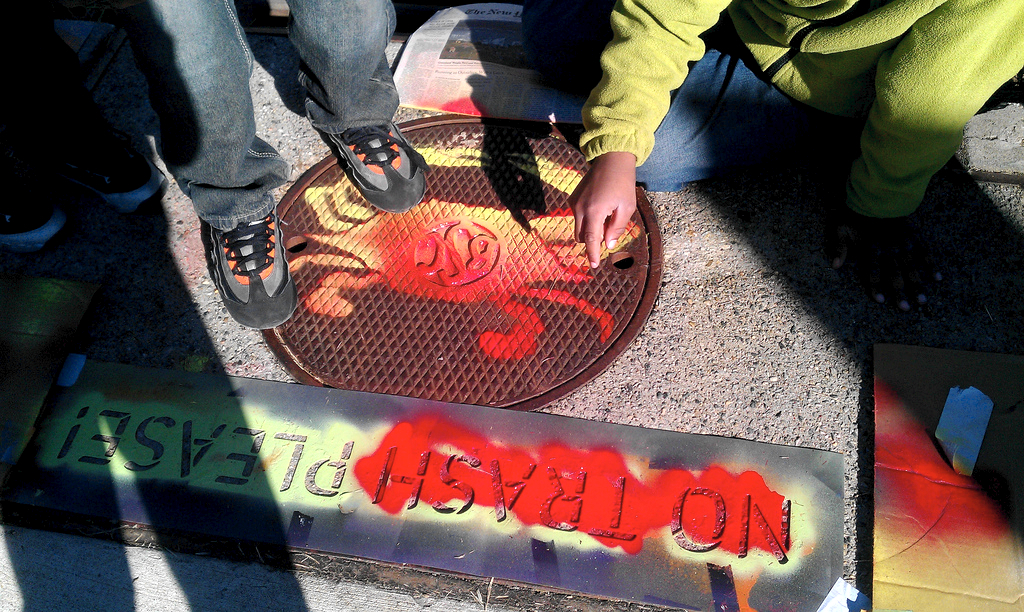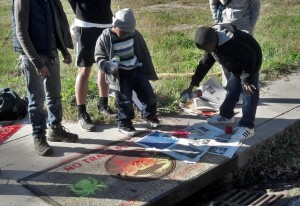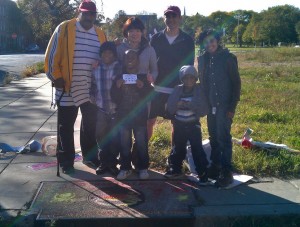Storm Drain Stenciling in Baltimore
[Note: Amy Dewan is the Americorps Storm Drain Arts Coordinator for Blue Water Baltimore. She is an environmental justice organizer, educator, and artist from Baltimore, MD.]

With a mere week left in my AmeriCorps term here at Blue Water Baltimore, I feel as if my three-month term has flown by. We just launched the Storm Drain Stencil Share program, and I am now starting to notice painted drains when I take long walks around the city. They make me feel like I’ve left some sort of mark here, though really the majority of the drains have been artistically rendered by the love and labor of the communities that they are in. That is how it should be, I think.
Without doubt, the best part of my job has been talking to folks around the city and introducing them to our stencil share and other programs. I found that even in the most “vacant” and boarded up neighborhoods there is inevitably a tight-knit block or two with dedicated neighbors who are working constantly to make their community a better place.

In many ways, the trash situation in Baltimore City is a lot more complicated than I was prepared for. What began as a job where I spread the word about how “trash in the street pollutes what we eat” has become a learning experience about the diversity of neighborhoods and communities around Baltimore City. Each has a complicated relationship with their environment, often due to factors outside their control.
For example, during a presentation to high-school students in the Fayette Street/Bon Secours neighborhood I found out that they had already led their own street cleanups. Most of their questions had to do with what they should do with the trash afterwards, since there are not many trash collection points in their community. They were also curious about what happens to trash after it’s collected, and where it goes, since I mentioned that trash rarely dematerializes.
I helped a volunteer teacher give a lesson on water at the Edgar Allen Poe Homes, also in southwest Baltimore. Thirty kids packed themselves into the living room of the small house that was hosting us, some kids overflowing into the kitchen. Most of the young children already knew the different phases of water, where water went from our storm drains, and the native animals of the Chesapeake Bay. One girl asked me why hot water freezes faster than cold water, which I still need to look up.

Apart from the humbling experience of kids teaching me things I didn’t know about our world and their own communities, I also had an opportunity to play art teacher (or, rather, an art-enabler). Kids love spray painting stencils on a storm drain for all the reasons you would think: because they don’t often get to decide what goes on public property, because holding a spray paint can feels rebellious, and because they get a chance to educate people in the neighborhood about their storm drains.
Of course, our projects and volunteers are not limited to kids. I had some great experiences working with community members of all ages on storm drain projects. The magic of art to me is that the free spirited part of everyone comes out when the job to do requires bright colors and imagination.
The act of painting a storm drain has had a positive effect in every community we work with, given the multi-dimensional art and social change aspects of the projects. In the end, that’s the heart of the positive impact these stencils and art projects have. In any part of the city and in anyone’s life, the act of producing art is therapeutic and builds community when it can be done with neighbors and family. All of a sudden, a drain with rainbow crabs and oysters on it becomes a visible and tangible manifestation of the love that individuals and communities have for their neighborhoods. This love is the spark that will help our city become cleaner and more beautiful.
